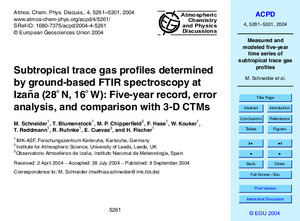Por favor, use este identificador para citar o enlazar este ítem:
http://hdl.handle.net/20.500.11765/6492
Subtropical trace gas profiles determined by ground-based FTIR spectroscopy at Izaña (28° N, 16° W): Five-year record, error analysis, and comparison with 3-D CTMs [Discussion paper]
| Título : | Subtropical trace gas profiles determined by ground-based FTIR spectroscopy at Izaña (28° N, 16° W): Five-year record, error analysis, and comparison with 3-D CTMs [Discussion paper] |
| Autor : | Schneider, Matthias
 ; Blumenstock, Thomas; Chipperfield, Martyn P.; Hase, Frank; Kouker, W.; Reddmann, T.; Ruhnke, Roland; Cuevas Agulló, Emilio
; Blumenstock, Thomas; Chipperfield, Martyn P.; Hase, Frank; Kouker, W.; Reddmann, T.; Ruhnke, Roland; Cuevas Agulló, Emilio



|
| Palabras clave : | FTIR spectroscopy; Trace gas; Ozone depletion; Gases traza; Espectrómetros; Reducción de la capa de ozono |
| Fecha de publicación : | 2004 |
| Editor: | European Geosciences Union |
| Citación : | Atmospheric Chemistry and Physics Discussions [Preprint]. 2004, 4, p. 5261–5301 |
| Versión del editor: | http://www.atmos-chem-phys.net/5/153/2005/ |
| Resumen : | Within the framework of the NDSC (Network for the Detection of Stratospheric Change) ground-based FTIR solar absorption spectra have been routinely recorded at Izaña Observatory (28° N, 16° W) on Tenerife Island since March 1999. By analyzing the shape of the absorption lines, and their different temperature sensitivities, the vertical distribution of the absorbers can be retrieved. Unique time series of subtropical profiles of O3, HCl, HF, N2O, and CH4 are presented. The effects of both dynamical and chemical annually varying trace gas cycles can be seen in the retrieved profiles. These include enhanced upwelling and photochemistry in summer and a more disturbed atmosphere in winter, which are typical of the subtropical stratosphere. A detailed error analysis has been performed for each profile. The output from two different three-dimensional (3-D) chemical transport models (CTMs), which are forced by ECMWF analyses, are compared to the measured profiles. Both models agree well with the measurements in tracking abrupt variations in the atmospheric structure, e.g. due to tropical streamers, in particular for the lower stratosphere. Simulated and measured profiles also reflect similar dynamical and chemical annual cycles. However, the differences between their mixing ratios clearly exceed the error bars estimated for the measured profiles. Possible reasons for this are discussed. |
| Patrocinador: | We thank the Bundesministerium für Bildung und Forschung via the DLR by contracts 50EE0008 and 50EE0203 for funding |
| URI : | http://hdl.handle.net/20.500.11765/6492 |
| ISSN : | 1680-7367 1680-7375 |
| Colecciones: | Artículos científicos 2000-2004 |
Ficheros en este ítem:
| Fichero | Descripción | Tamaño | Formato | ||
|---|---|---|---|---|---|
| acpd-4-5261-2004.pdf | 3,37 MB | Adobe PDF |  Visualizar/Abrir |
Los ítems de Arcimis están protegidos por una Licencia Creative Commons, salvo que se indique lo contrario.





